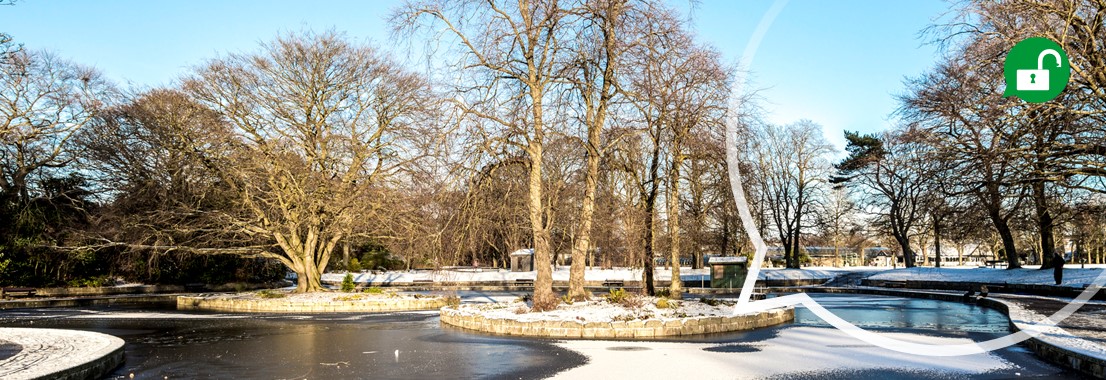
Dangers of ice: Protecting lives with winter water safety
Dangers of ice: Protecting lives with winter water safety
Winter's icy charm can be captivating, but beneath its surface lies a perilous hazard that should never be underestimated. Carlene McAvoy, our Leisure Safety Manager, highlights the risks associated with ice and how to take the necessary precautions...
In the United Kingdom, ice-covered lakes, canals, and lochs may look beautiful, but they hide a danger that can prove fatal. Each year, we hear of harrowing incidents involving individuals who venture onto frozen waters, be it for a shortcut, play, or merely a walk with their furry friends. To ensure your safety and that of your loved ones, it's important to understand the risks associated with ice and take the necessary precautions.
The appeal of frozen water
Children, in particular, are drawn to the magic of frozen water bodies. They see these icy surfaces as natural playgrounds, oblivious to the danger. Yet ice is unforgiving and can pose severe threats, even in the UK's milder winters.
The hidden dangers
One of the most alarming scenarios we encounter during winter months is individuals falling through the ice. These incidents often involve dog walkers, hikers, and the general public, who either use ice as a shortcut or engage in recreational activities on frozen water bodies. The consequences can be devastating, as ice in the UK often cannot reliably support a person's weight.
Ice safety advice for winter walkers
- Plan your route: If you intend to explore areas near waterways in winter, always plan your route in advance. Familiarity with your surroundings can be a lifesaver.
- Observe signs and warnings: Pay close attention to signs and warnings placed near water bodies. These signs are there for a reason, indicating non-obvious hazards that you should be aware of.
- Stay off the ice: Under no circumstances should you venture onto the ice or frozen waters. The temptation may be strong, but the risk is even stronger.
- Beware of the edge: Keep a safe distance from the edge of frozen water. Snow and leaves can obscure the boundary, making it treacherous.
- Supervise children: When around ice and waterways, keep a watchful eye on children at all times. Their curiosity can lead them into dangerous situations.
- Control your pets: If you have a dog with you, keep it on a lead when near ice and frozen waters. Avoid throwing sticks or balls onto the ice, as this can encourage your pet to venture onto unstable surfaces.
What to do if you see someone in the water
Should you encounter a person in the water, swift and informed action can make all the difference. Here's what you should do:
- Stay off the ice: Don’t attempt to go onto the ice yourself, as it may not support your weight
- Call for help: Dial 999 immediately and ask for assistance from the emergency services. Time is of the essence in such emergencies.
- Make contact: shout or speak to the person and reassure them that assistance is on the way. Use a reassuring voice to keep them calm. If they are unable to exit the water, encourage them to Float.
- Maintain contact: Speak to the person throughout and, if possible, keep your eyes on the person in distress, especially if the water is moving. This can help rescuers locate them more easily.
- Look for Rescue equipment: Look around for rescue equipment or items that can extend your reach, such as a rope, pole, branch, or even a piece of clothing.
- Reach or throw: Use the found equipment to reach out to the casualty. Gently guide and move them towards the shore, ensuring you remain on stable ground. Do not go on the ice.
- Keep warm: Once on dry land, keep the casualty warm and comfortable. It is crucial that they seek medical attention immediately, even if they appear unharmed.
While the beauty of frozen water bodies may be alluring, their dangers should never be underestimated. Ice, especially in the UK's temperate climate, is unpredictable and hazardous. By following the ice safety advice here and knowing how to respond in case of emergencies, we can protect ourselves and our loved ones from the potentially life-threatening risks associated with frozen waters. Always prioritise safety, and remember that ice is a force to be respected and never toyed with.
To find out more about what RoSPA is doing to prevent drowning, visit our water and leisure advice and information webpages at: https://www.rospa.com/leisure-water-safety/water/advice
Carlene McAvoy is RoSPA's Leisure Safety Manager.
Already a member? Login to MyRoSPA to read more articles

Login to you MyRoSPA account
Login to MyRoSPA to view exclusive member content
Login
| Join RoSPA
Become a member now
Become a member to access MyRoSPA to view more exclusive content
Join
Already a member? Login to MyRoSPA to read more articles

Login to you MyRoSPA account
Login to MyRoSPA to view some more exclusive content
Login
| Join RoSPA
Become a member now
Become a part of the MyRoSPA team to view more exclusive content
Register